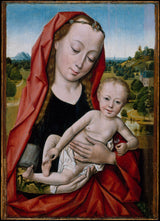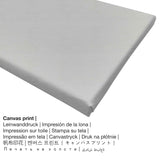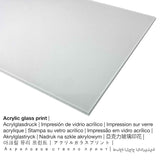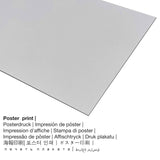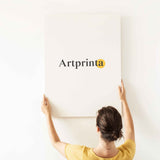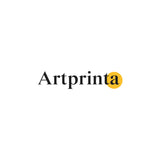Dieric Bouts, 1475 - Nwa agbọghọ na-amaghị nwoke na nwa - mbipụta nka mara mma
Ụtụ gụnyere. Mbupu gbakọrọ na ndenye ọpụpụ.
Nkọwa ngwaahịa ebipụta zuru oke
This over 540 year-old painting was made by the artist Dieric Bouts in 1475. Emere eserese ahụ na nha: N'ozuzu 11 1/2 x 8 1/4 na (29,2 x 21 cm); elu agba 11 1/4 x 7 3/4 inch (28,6 x 19,7 cm). Oil on wood was used by the artist as the medium of the work of art. Furthermore, the artwork forms part of the Ụlọ ihe ngosi nka nke Metropolitan digital art collection, which is one of the world's largest and finest art museums, which includes more than two million works of art spanning five thousand years of world culture, from prehistory to the present and from every part of the globe.. We are pleased to reference that this artwork, which is in the ngalaba ọha is being included with courtesy of The Metropolitan Museum of Art, New York, The Jack and Belle Linsky Collection, 1982. Creditline of the artwork: Nchịkọta Jack na Belle Linsky, 1982. Ọzọkwa, itinye n'usoro mmepụta dijitalụ dị Eserese format ma nwee oke nke 1: 1.4, nke pụtara na ogologo bụ 29% mkpụmkpụ karịa obosara.
Original artwork information by The Metropolitan Museum of Art (© - by The Metropolitan Museum of Art - Museumlọ ihe ngosi nka nke Obodo)
This tender image of the Virgin and Child is the finest surviving copy of a lost prototype painted by Bouts near the end of his life. Among fifteen other examples, it is set apart by the high quality of its landscape background and the subtlety of its modeling. The Child plays with the big toe on his right foot, a gesture that could have implied an invitation to the viewer to follow in Christ’s footsteps. In his left hand he holds a pink, which also had symbolic meaning, since the Greek name for this flower, dianthose, means "flower of God."
Nkọwa ihe osise
| Aha eserese: | "Vergin na Nwa" |
| Nhazi nke ọrụ nka: | sere |
| Otu izugbe: | nka ochie |
| Time: | 15th narị afọ |
| Emepụtara n'afọ: | 1475 |
| Afọ nka: | ihe dị ka afọ 540 |
| Usoro nka izizi: | mmanụ n'elu osisi |
| Akụkụ izizi: | N'ozuzu 11 1/2 x 8 1/4 na (29,2 x 21 cm); elu agba 11 1/4 x 7 3/4 inch (28,6 x 19,7 cm) |
| Ụlọ ihe ngosi nka / mkpokọta: | Museumlọ ihe ngosi nka nke Obodo |
| Ebe ebe ngosi nka: | New York City, New York, Njikota Obodo Amerika |
| E Nwere na: | www.metmuseum.org |
| Ikikere nke ihe osise: | ngalaba ọha |
| Site n'aka: | Ụlọ ihe ngosi nka nke Metropolitan, New York, Jack na Belle Lindsky mkpokọta, 1982 |
| kreditline ọrụ nka: | Nchịkọta Jack na Belle Linsky, 1982 |
Data omenka ahaziri ahazi
| Aha onye nka: | Dieric Bouts |
| Gender: | nwoke |
| Nationality: | Dutch |
| Ọrụ onye na-ese ihe: | onye na-ese ihe |
| Obodo obibi: | mba netherland |
| Nhazi nke onye nka: | nna ukwu ochie |
| Nwụrụ na afọ nke: | 65 afọ |
| Afọ amụrụ: | 1410 |
| Amụrụ na (ebe): | Haarlem |
| Afọ nwụrụ: | 1475 |
| Ebe ọnwụ: | Leuven |
Nye iwu ihe ị họọrọ
Maka mbipụta nka ọ bụla, anyị na-enye nha & ihe dị iche iche. Ị nwere ike ịhọrọ n'ime nhọrọ nhazi ngwaahịa ndị a:
- Mbipụta enyo acrylic: An acrylic glass print, which is often denoted as a UV print on plexiglass, will change your favorite original artwork into great home decoration.
- Ebipụta akwụkwọ mmado na ihe akwa akwa: Our poster print is a printed cotton canvas with a fine surface texture, which reminds the actual work of art. Please keep in mind, that depending on the absolute size of the poster print we add a white margin 2 - 6cm around the painting, which facilitates the framing with your custom frame.
- Kwaaji: The canvas print is a printed cotton canvas stretched on a wood frame. It has a exclusive impression of three dimensionality. How do I hang a canvas print on the wall? A canvas print has the advantage of being low in weight. This means, it is easy to hang up your Canvas print without the support of any wall-mounts. Because of thata canvas print is suitable for any kind of wall in your home.
- Aluminom dibond mbipụta (ọla): An Aluminium Dibond print is a print material with an outstanding effect of depth - for a modern impression and non-reflective surface structure. The bright sections of the work of art shimmer with a silk gloss but without the glow. The colors of the print are bright and vivid in the highest definition, fine details are very clear.
Nkọwa ngwaahịa
| Bipụta ngwaahịa: | ọmarịcha nka |
| Mmeputakwa: | dijitalụ mmeputakwa |
| Usoro mmepụta: | Mbipụta UV ozugbo (mbipụta dijitalụ) |
| Production: | German mmepụta |
| Stockdị ngwaahịa: | na mmepụta ihe |
| Ojiji ngwaahịa: | mgbidi mma, art ebipụta gallery |
| Nhazi: | usoro eserese |
| Oke akụkụ onyonyo: | (ogologo: obosara) 1: 1.4 |
| Ntụgharị nkọwa akụkụ onyonyo: | ogologo bụ 29% mkpụmkpụ karịa obosara |
| Ụdị ihe dị iche iche dị: | ígwè obibi akwụkwọ (aluminium dibond), ebipụta canvas, mbipụta enyo acrylic (nwere ezigbo mkpuchi iko), mbipụta akwụkwọ mmado (akwụkwọ kwaaji) |
| Nhọrọ nha nke akwa akwa n'elu etiti ihe na-agbatị (mbipụta kwaaji): | 50x70cm - 20x28", 100x140cm - 39x55" |
| Acrylic glass print (nwere ezigbo mkpuchi iko) nhọrọ: | 50x70cm - 20x28", 100x140cm - 39x55" |
| Ụdị akwụkwọ mmado (akwụkwọ kwaaji) dị iche iche: | 50x70cm - 20x28" |
| Nhọrọ mbipụta aluminom: | 50x70cm - 20x28", 100x140cm - 39x55" |
| ụba: | enweghị etiti |
Legal disclaimer: We try what we can in order to describe the art products with as many details as possible and to demonstrate them visually in our shop. At the same time, the tone of the printed materials, as well as the printing may vary slightly from the representation on the screen. Depending on the settings of your screen and the nature of the surface, not all colors are printed as realistically as the digital version depicted here. Since the fine art prints are processed and printed by hand, there might also be minor deviations in the exact position and the size of the motif.
© Nchekwa ikike nwebisiinka - Artprinta.com (Artprinta)

